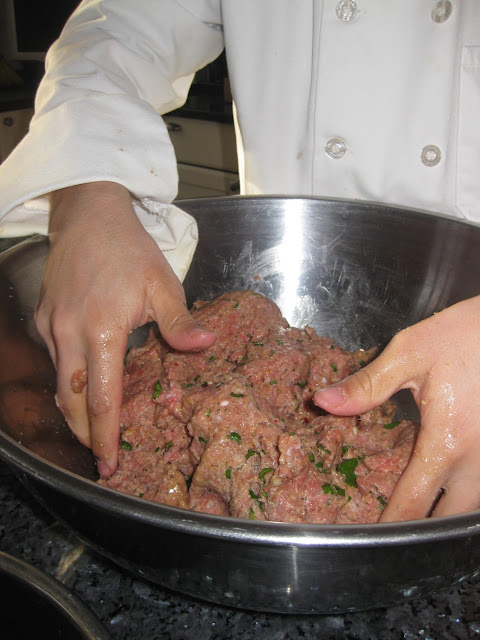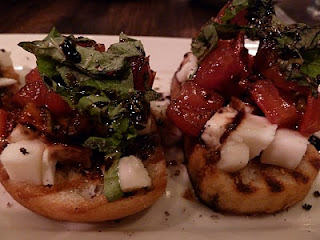It's 101 Thursday again... and today it's all about PROSCIUTTO!!!
Prosciutto is the Italian word for ham, although us Americans use the word prosciutto to refer to a thinly-sliced, dry-cured ham. The meat is served uncooked in a style called prosciutto crudo in Italian, which distinguishes it from Italian cooked ham, prosciutto cotto.
The best prosciutto comes from Italy, from central regions like Tuscany and Emilia Romagna, and from the northern regions like Friuli-Venezia Giulia and San Daniele. Prosciutto di Parma (prosciutto from the Parma province in Emilia Romagna)) is one of the most renowned Italian cities to produce some of the best and most expensive legs of prosciutto.
 |
| Salting the ham |
Prosciutto is from either a pig's leg or from a wild boar's thigh. I have always known that prosciutto was ham, and that ham comes from a pig; I was confused to read that it could also be from a wild boar. I have never really thought about wild boars in specifics, other than it's an animal, but didn't realize a wild boar is simply an uncastrated male swine, or pig. You learn something new everyday!
 |
| Prosciutto di Parma |
Back to the meat... prosciutto is a slow-cured meat and can take anywhere from 9 months to 2 years!! There are several types of prosciutto, each distinguished from the next by where and how the ham is produced. The European Union and Italian government have a similar protection agency as they do for Italian wines; the legislation has granted a special "protected designation of origin" to several of the raw hams, which are regulated to monitor the quality and processing of the ham.
 |
Parma Province, in
Emilia Romana, central Italy |
The best, in my opinion, is Prosciutto di Parma, which is produced by over 200 curers in the Parma Province. Prosciutto di Parma is made from only large, fresh hams (26 - 30lbs). Although it's a salty meat, the curing process uses relatively little salt, but can also use garlic salt and sugar for a sweeter meat. After the meat is salted with sea salt, it is sealed with pig fat to slow the drying process. Curing occurs over a minimum of 12 months for certified Prosciutto di Parma and uses only salt--no nitrates, no spices, and no conserving substances. The ham is salted and left to settle for about 2 months; it is slowly pressed throughout the time to avoid breaking the ham bone, but simultaneously drain the meat. It is washed repeatedly to remove the salt and then hung in a dark and well-ventilated room. It is left to dry completely over time, then hung to air out in a controlled environment, or at room temperature, for up to 2 years!
Now, what do you do with prosciutto?
 Some of my favorite recipes are some of the easiest...
Some of my favorite recipes are some of the easiest...
- Try wrapping steamed or grilled asparagus in prosciutto...
- If you like tomato, basil, and mozzarella -- serve a sandwich on focaccia bread with T, B, & M plus prosciutto and good balsamic vinegar... my FAVORITE sandwich in the WHOLE WIDE WORLD!!
A new one that Ina Garten (The Barefoot Contessa) taught me is...
 GRILLED BREAD WITH PROSCIUTTO from her new cookbook, How Easy is That? In Italy, grilled bread rubbed in garlic is known as fettunta, which is the foundation of this recipe. The bread is at its ABSOLUTE BEST if you ACTUALLY GRILL IT OVER AN OPEN FLAME!! I know it's a little more annoying, but the charred taste it gets is incredible. (I tried to take pictures, but it's getting dark by 5:30pm here and the flash totally distorted the whole beauty of grilling the bread!) The bread is delicious on its own, but Ina shows how to put some prosciutto, mozzarella, and a drizzle of olive oil before putting it back in the oven (to melt the cheese, of course) and DELICIOZO! And seriously, could anyone mess that up?!?!
GRILLED BREAD WITH PROSCIUTTO from her new cookbook, How Easy is That? In Italy, grilled bread rubbed in garlic is known as fettunta, which is the foundation of this recipe. The bread is at its ABSOLUTE BEST if you ACTUALLY GRILL IT OVER AN OPEN FLAME!! I know it's a little more annoying, but the charred taste it gets is incredible. (I tried to take pictures, but it's getting dark by 5:30pm here and the flash totally distorted the whole beauty of grilling the bread!) The bread is delicious on its own, but Ina shows how to put some prosciutto, mozzarella, and a drizzle of olive oil before putting it back in the oven (to melt the cheese, of course) and DELICIOZO! And seriously, could anyone mess that up?!?!
GRILLED BREAD WITH PROSCIUTTO
 makes 6 slices... perfect for an appetizer and filling enough for a small(ish) dinner for roomies!
makes 6 slices... perfect for an appetizer and filling enough for a small(ish) dinner for roomies!Ingredients:
6 slices of GOOD Tuscan round bread (sliced into 3/4-in thick slices)
2 large cloves of garlic (cut in half)
2 oz thinly sliced prosciutto, torn roughly into pieces
2 oz fresh mozzarella, grated**
3 tbsp minced fresh parsley
**the recipe calls for smoked mozzarella, but I have to admit that I HATE smoked mozzarella... so I took it upon myself to use fresh mozzarella and it was AMAZING!!! I didn't feel like anything was missing by substituting fresh mozzarella for smoked.
Preparation:
Prepare a charcoal grill with medium-hot coals (this is what I had access to at our apartment complex, but I want to try it at home in NY on our gas grill, which Ina suggests to prepare at medium-high heat).
Grill the bread for about 2 minutes on ONE side. Remove from the grill and place grilled side up on a platter
IMMEDIATELY (this is important) rub the grilled side of the bread with the cut side of a garlic clove. If you like, excuse me, LOVE garlic like I do, you can make it extra garlicky by using 2 cloves instead of 1 (like I did) and by rubbing the garlic fairly hard on the surface of the bread.
Drizzle the bread with the olive oil.
Place the torn prosciutto over the grilled, oiled, garlicked side of the bread and top with the grated mozzarella too!
Return the jazzed-up bread to the grill, cover the grill, and cook just long enough to melt the cheese and re-warm the toast (about 1-2 minutes). MAKE SURE to leave the vent open so that the fire stays lit.
This is EXCELLENT with a great glass of Chianti or a Super Tuscan red vino from Italy!
Sit back, sip your vino, and bite into a crunchy slice of delicious, hot, garlicky slice of Tuscan bread with mozz and prosciutto!




































